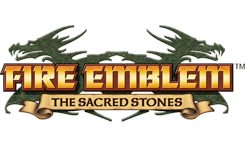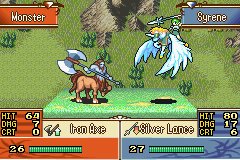|
|

|
BATTLE SYSTEM
|

|
INTERACTION
|

|
ORIGINALITY
|

|
STORY
|

|
MUSIC & SOUND
|

|
VISUALS
|

|
CHALLENGE
|
Difficult
|
COMPLETION TIME
|
20-30 hours
|
|
OVERALL
3.5/5
|
Rating definitions
|
|
|
As the Tactical RPG genre has grown in recognition and popularity, it was inevitable that a few would manage to make their way to the handheld systems. Received with mixed feelings, the quality of TRPGs has been touch and go on the GameBoy Advance. Though the Fire Emblem series didn't appear until its seventh iteration, it was received by many players with open arms. Now, it's sequel, Fire Emblem: The Sacred Stones, has graced handhelds both far and wide, with much anticipation as to whether it would improve upon the first sampling North America saw. With its immersive battle system, pulling storyline, and energizing music, it will appeal to many RPGamers; those that don't mind the length of battles as well as a greatly increasing difficulty.
Like most tactical RPGs, The Sacred Stones follows the usual formula: a map that allows exploration, including areas to engage in battle that trigger a storyline snippet, a battle, and a concluding storyline snippet. However, the actual battle process is an elaborate chess game. Battles are full of important decisions, especially since this Fire Emblem brings the idea of multiple class branches. The maximum level of almost every class is 20 (a rare couple cap at 10), though at 10 they may choose to advance to the next class providing that they acquire the correct item to advance with. At each class change, there will be two branches to choose from, which may be similar or very different from each other. Some will be mounted, while some remain on foot. Some require completely new weapons, while many retain their original equipment selections.
At the start of each battle, the player, as the mastermind of strategy, must choose who will sally out onto the battlefield, organizing their items, checking their stats, and also examining relationships. Brought over from the previous Fire Emblem GBA game, but in greater detail, relationships affect how the characters interact and support each other. Not all characters relate to each other; those that have a reason for having an emotional connection, if they stand next to each other on the battlefield, will have a comraderie grow between them until an option called "support" appears, triggering a conversation on the battlefield. A character may have no relationship, or if a support conversation is triggered they may develop a further relationship, denoted by C, B, or A (one, two, and three conversations respectively), and those who have established a relationship in this fashion can support their fellow soldier from up to three squares away.
 Monsters Also Appear As Enemies
Monsters Also Appear As Enemies
|
|
Any character may have a maximum of five relationship levels; this could be 5 different 'c' levels, or any combination of a's, b's and c's. If a character is defeated in battle, they are permanantly removed from the game, and their relationships no longer count towards the other characters' totals. During battle, there may be characters who can be brought over to fight on the player's side, whether they be neutral characters or enemies. Sending a sympathetic character to stand beside them will trigger the action "Talk", and this conversation may lead them to join the character's cause.
Once the soldiers take the field, turns progress by stage. First, the player moves; then the enemy's turn takes place; finally, if there are any neutral units, they act last. The characters may be moved in any order, and have a variety of actions they may choose from. When it comes to attacking, moving is only allowed before an attack. In comparison, other actions may be preceeded or followed by a movement - such as equipping, or pulling from storage, different items. Characters also have the option of 'rescuing' another character, proving they have the ability to do so. Those mounted on horseback may move again once they have performed a rescue. Once two combatants square off, the fun really begins. A weapons triangle (as well as a magic triangle) will dictate how weapons will fare against each other. This rock-paper-scissors setup is simple but effective. Swords beat Axes beat Spears beat Swords; naturally, there are some weapons which reverse this triangle - such as a sword called Axebreaker - and the small display before two opposing characters will tell which weapon, if either, has the advantage, the projected damage, the percent to hit and the critical percent. Magic attacks work the same (Anima beats Light beats Dark beats Anima), as do ranged attacks. If possible, whenever attacked, the opposing character will counterattack. Performing any action besides moving, whether it be attacking, counterattacking, healing, dancing, or using an item such as lighting a torch, will net the character experience. Different battles have a variety of goals to complete the battle, including simply surviving, defeating a boss, or capturing a specific town. Battles become extremely challenging as the game continues due to the massive disparity between the player's maximum troops and the grand number of enemies they must defeat or repel to succeed in a level. Though very challenging, defeating each level is a satisfying experience.
While the graphical capability of a GBA is not on par with other consoles, that doesn't mean its games can't look good, and this title is no exception. Those not enamoured with anime-style graphics may at first be hesistant to pick up the title, but don't let the visual style be a turnoff. With so few 2D sprite offerings, it's nice to see one or two still sneaking in.
 Blue = Good; Green = Neutral; Red = BAD!
Blue = Good; Green = Neutral; Red = BAD!
|
|
There is plenty of variation in the levels and people, though naturally some sprites overlap among allies, enemies, and maps. The visual environment is well supported by the musical score accompanying the game. Definitely setting the mood, though the music does become repetitive after a while considering how long some of the later levels are, it nonetheless fulfills its role well.
One of the features of the Fire Emblem series is its difficulty. Not for the feint of heart, Sacred Stones is no different. As mentioned before, once a party member perishes they are removed from the game entirely, so both maintaining current units as well as recruiting as many new units as possible is necessary to balance the number of troops available for each battle. As time goes by, more and more troops will be allowed onto the battlefield and they will be put to serious tests, so upgrading units at the right time is also a must. If a character dies and the player wishes to try to save them, the entire level must be redone as each turn is autosaved to prevent simply switching off the game to nullify the death. This, in turn, may increase the time needed to complete all of the chapters of the game. In addition, the difficulty also varies based upon which paths are taken throughout the course of the game. Those who are suave tacticians may sail through the game in as little as 20 hours, though it is just as likely to take 30 hours to polish off this particular gem.
Similar to other Tactical RPGs, most of the game revolves around the battles. So, an important part of the game must be both a solid menu system and interface, as well as a polished localization. Thankfully, both are delivered in fine fashion. While the interface has been covered simply by explaining how the battle system works, it is difficult to truly qualify a translation of a game where the story is given in chunks. These chunks do an excellent job of tying together between battles, giving reason for each successive battle, and there are no noticeable errors found in the textual translation. The characters do have somewhat shallow personalities but, due to the structure of the game, there is little time to flesh out many beyond the basic characteristics, though conversations aid greatly in really finding out what motivates a character and how they feel.
The story of Sacred Stones is a compelling tale of two siblings during a time of war; this sort of story is also present in the previous Fire Emblem game on the GBA. During the game, their story splits into two paths, which eventually reconverge, and give specific detail to either the brother or the sister depending on whose path is chosen. This, along with the way the game is presented, gives the title a fair share of originality.
 A Disadvantage
A Disadvantage
|
|
While many features of the game come from previous titles in the series, this entry takes those concepts and runs with them. It is both the differences as well as the similarities that makes the game a solid package.
Fire Emblem fills a role few other games dare to: it is definitely a challenging title to play, yet it is completely unapologetic about being so. Few games released around the same time could truly boast the same characteristics of both fun and difficulty with all the right trimmings included. Though the fact that the game is hard may scare off people, it is definitely a game any RPGamer who enjoys a tactical RPG with a decent storyline and enjoyable gameplay should be picking up and adding to their portable gaming collection.
Review Archives
|









